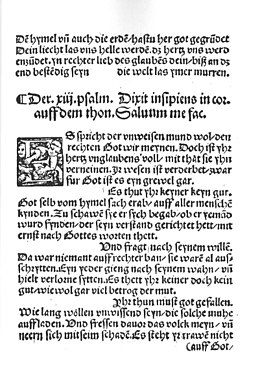| "Es spricht der Unweisen Mund wohl" | |
|---|---|
| Hymn by Martin Luther | |
 Der XIII. Psalm. "Dixit insipiens in cor., Erfurt Enchiridion, 1524 | |
| English | "The mouth of fools doth God confess" |
| Text | by Martin Luther |
| Language | German |
| Published | 1524 |

"Es spricht der Unweisen Mund wohl" ("The mouth of fools doth God confess") [1] is a Lutheran hymn of 1524, with words written by Martin Luther in 1523, paraphrasing Psalm 14. It was published as one of eight songs in 1524 in the first Lutheran hymnal, the Achtliederbuch. It was also published later that year in the Erfurt Enchiridion. It has appeared in many hymnals, both in German and in translation. The text inspired vocal and organ music by composers such as Johann Pachelbel.